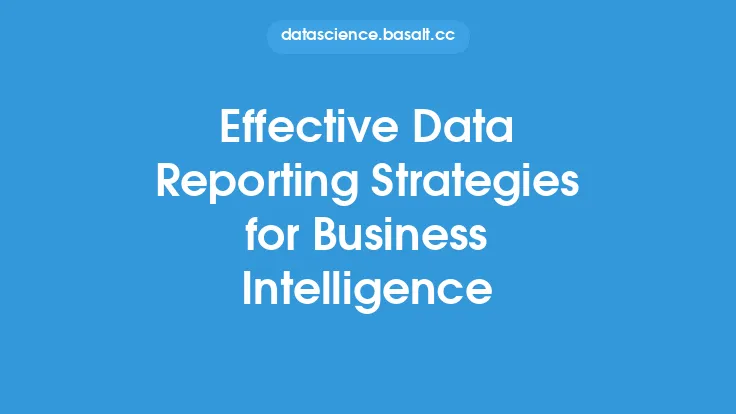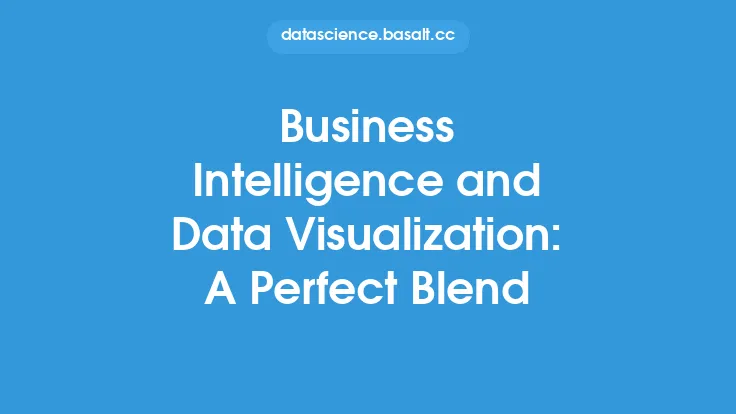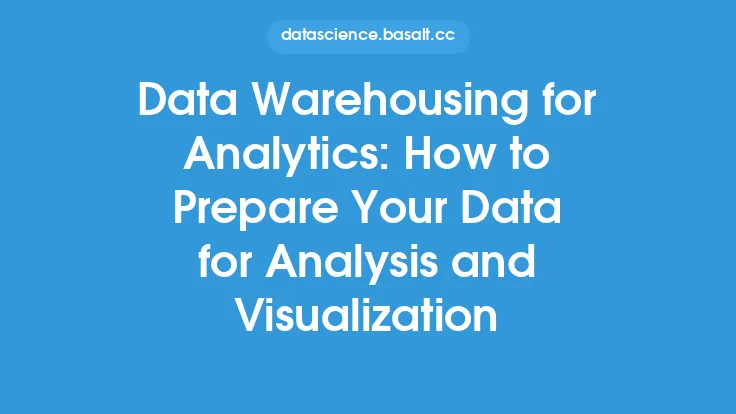Data warehousing and business intelligence are crucial components of an organization's data strategy, enabling informed decision-making and driving business growth. A well-designed data architecture is essential for supporting these initiatives, providing a foundation for the integration, storage, and analysis of large volumes of data. In this article, we will delve into the key considerations and best practices for designing a data architecture that supports data warehousing and business intelligence.
Introduction to Data Warehousing and Business Intelligence
Data warehousing and business intelligence are closely related concepts that work together to provide insights and support decision-making. A data warehouse is a centralized repository that stores data from various sources, providing a single, unified view of an organization's data. Business intelligence, on the other hand, refers to the processes and technologies used to analyze and interpret data, providing insights and recommendations to stakeholders. A well-designed data architecture is critical for supporting these initiatives, ensuring that data is properly integrated, stored, and analyzed.
Key Components of a Data Architecture for Data Warehousing and Business Intelligence
A data architecture for data warehousing and business intelligence typically consists of several key components, including:
- Data sources: These are the systems and applications that generate data, such as customer relationship management (CRM) systems, enterprise resource planning (ERP) systems, and social media platforms.
- Data integration: This refers to the processes and technologies used to extract, transform, and load (ETL) data from various sources into a centralized repository.
- Data warehouse: This is the centralized repository that stores data from various sources, providing a single, unified view of an organization's data.
- Data marts: These are smaller, specialized repositories that contain a subset of data from the data warehouse, optimized for specific business needs or departments.
- Business intelligence tools: These are the applications and technologies used to analyze and interpret data, providing insights and recommendations to stakeholders.
- Data governance: This refers to the policies, procedures, and standards used to manage and ensure the quality of an organization's data.
Data Warehouse Design Considerations
When designing a data warehouse, there are several key considerations to keep in mind. These include:
- Data modeling: This refers to the process of creating a conceptual representation of an organization's data, including entities, relationships, and attributes.
- Data normalization: This refers to the process of organizing data to minimize data redundancy and improve data integrity.
- Data denormalization: This refers to the process of intentionally denormalizing data to improve query performance and reduce complexity.
- Data partitioning: This refers to the process of dividing large datasets into smaller, more manageable pieces, improving query performance and reducing storage requirements.
- Data indexing: This refers to the process of creating indexes on columns used in queries, improving query performance and reducing the time it takes to retrieve data.
Business Intelligence Tool Selection
When selecting business intelligence tools, there are several key considerations to keep in mind. These include:
- Data analysis: This refers to the ability of the tool to analyze and interpret data, providing insights and recommendations to stakeholders.
- Data visualization: This refers to the ability of the tool to present data in a clear and concise manner, using charts, graphs, and other visualizations.
- Reporting: This refers to the ability of the tool to generate reports, providing stakeholders with timely and accurate information.
- Dashboards: This refers to the ability of the tool to create dashboards, providing stakeholders with a centralized view of key performance indicators (KPIs) and metrics.
- Collaboration: This refers to the ability of the tool to support collaboration and sharing, enabling stakeholders to work together and make informed decisions.
Data Governance and Quality
Data governance and quality are critical components of a data architecture for data warehousing and business intelligence. Data governance refers to the policies, procedures, and standards used to manage and ensure the quality of an organization's data. This includes data validation, data cleansing, and data normalization, as well as data security and access controls. Data quality, on the other hand, refers to the accuracy, completeness, and consistency of an organization's data. This includes data profiling, data monitoring, and data certification, as well as data remediation and data archiving.
Scalability and Performance
Scalability and performance are critical considerations when designing a data architecture for data warehousing and business intelligence. Scalability refers to the ability of the architecture to handle increasing volumes of data and user activity, without compromising performance. Performance, on the other hand, refers to the ability of the architecture to provide timely and accurate results, supporting informed decision-making and business growth. To ensure scalability and performance, it is essential to consider factors such as data partitioning, data indexing, and query optimization, as well as hardware and software configurations.
Security and Access Controls
Security and access controls are critical components of a data architecture for data warehousing and business intelligence. This includes authentication, authorization, and encryption, as well as data masking and data anonymization. Authentication refers to the process of verifying the identity of users and applications, ensuring that only authorized access is granted. Authorization, on the other hand, refers to the process of granting or denying access to data and resources, based on user roles and permissions. Encryption refers to the process of protecting data in transit and at rest, using algorithms and protocols to ensure confidentiality and integrity.
Conclusion
In conclusion, a well-designed data architecture is essential for supporting data warehousing and business intelligence initiatives. This includes key components such as data sources, data integration, data warehouse, data marts, business intelligence tools, and data governance. When designing a data warehouse, it is essential to consider factors such as data modeling, data normalization, and data partitioning, as well as data indexing and query optimization. Business intelligence tool selection should be based on factors such as data analysis, data visualization, and reporting, as well as collaboration and sharing. Data governance and quality are critical components of a data architecture, ensuring that data is accurate, complete, and consistent. Scalability and performance are also critical considerations, ensuring that the architecture can handle increasing volumes of data and user activity. Finally, security and access controls are essential for protecting sensitive data and ensuring confidentiality and integrity. By following these best practices and considerations, organizations can create a robust and scalable data architecture that supports informed decision-making and drives business growth.





